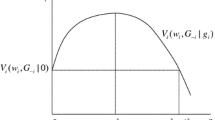Abstract
An important focus for concern about Contingent Valuation (CV) is that hypothetical payments for non-market goods are biased upwards in comparison to cash payments. Lack of realism, through its influence on incentives to mis-report payments, may explain the divergence. This paper reports on a study which attempts to overcome this problem by emulating a real fund-raising solicitation by the Isle of Eigg Trust for both real and hypothetical donations. In contrast to previous results, the mean cash donation was higher (£3.71) than the man CV donation (£3.41). A third survey, which used a neutral CV design, implemented by a research organization, obtained a mean donation which was much higher (£6.21) than the cash equivalent.
Similar content being viewed by others
References
Brown, T. C., P.A. Champ, R. C. Bishop and D. McCollum (1996), ‘Which Response Format Reveals the Truth about Donations to a Public Good’, Land Economics 72(2), 152-166.
Champ, P. A., R. C. Bishop, T. C. Brown and D. W. McCollum (1997), ‘Using Donation Mechanisms to Value Nonuse Benefits from Public Goods’, Journal of Environmental Economics and Management, forthcoming.
Diamond, P. A. and J. Hausman (1994), ‘Contingent Valuation: Is Some Number Better Than No Number?’, Journal of Economic Perspectives 8(4), 45-64.
Dillman, D. A. (1979), Mail and Telephone Surveys: The Total Design Method. New York: John Wiley and Sons.
Duffield, J.W. and D. A. Patterson (1992), ‘Field Testing Existence Values: Comparison of Hypothetical and Actual Cash Transaction Values’, in R. B. Rettig, comp., Benefits and Costs in Natural Resource Planning. Western Regional Research Report, Department of Agriculture and Resource Economics, Oregon State University Corvallis.
Fischoff, B. and L. Furby (1988), ‘Measuring Values: A Conceptual Framework for Interpreting Transactions with Special Reference to Contingent Valuation of Visibility’, Journal of Risk and Uncertainty 1, 147-184.
Foster, V., I. J. Bateman and D. Harley (1997), ‘Real and Hypothetical Willingness to Pay for Environmental Preservation: A Non-Experimental Comparison’, Journal of Agricultural Economics 48(2), 123-138.
Fredman, P. (1994), ‘A Test of Non-Response Bias in a Mail Contingent Valuation Survey’, Arbetsrapport 201. Sveriges Lantbruksuniversitet, Institutionne for Skogsekonomi.
Hanemann, W. M. (1994), ‘Valuing the Environment Through Contingent Valuation’, Journal of Economic Perspectives 3, 1-23.
Hoehn, J. P. and A. Randall (1987), ‘A Satisfactory Benefit Indicator from Contingent Valuation’, Journal of Environmental and Management 14, 226-247.
Kealy, M. J., M. Montgomery and J. F. Dovidio (1990), ‘Reliability and Predictive Validity of Contingent Values: Does the Nature of the Good Matter?’, Journal of Environmental Economics and Management 19, 244-263.
Loomis, J., T. Brown, B. Lucero and G. Peterson (1996), ‘Improving Validity Experiments of Contingent Valuation Methods: Results of Efforts to Reduce the Disparity of Hypothetical and Actual Willingness to Pay’, Land Economics 72(4), 450-461.
McCollum, D. W. and S. M. Miller (1994), Alaska Voters: Their Wildlife Viewing Trip Characteristics and Economics. Anchorage: Alaska Department of Fish and Game, Division of Wildlife Conservation.
Mitchell, R. C. and R. T. Carson (1989), Using Surveys to Value Public Goods: The Contingent Valuation Method. Washington, DC: Resources for the Future.
Navrud, S. and K. Veisten (1996), Validity of Nonuse Values in Contingent Valuation: An Empirical Test with Real Payments. Paper presented to the 7th EAERE Conference, Lisbon 1996.
Neill, H. R., R. G. Cummings, P. T. Ganderton, G. W. Harrison and T. McGuiken (1994), ‘Hypothetical Surveys and Real Economic Commitments’, Land Economics 70(2), 145-154.
NOAA (1993), ‘Natural Resource Damage Assessments: Proposed Rules’, Federal Register 59(5), 1062-1191.
Seip, K. and J. Strand (1992), ‘Willingness to Pay for Environmental Goods in Norway: A Contingent Valuation Study with Real Payment’, Environmental and Resource Economics 2(1), 91-106.
Sinden, J. A. (1988), ‘Empirical Tests of Hypothetical Bias in Consumers' Surplus Surveys’, Australian Journal of Agricultural Economics 32(2/3), 98-112.
Author information
Authors and Affiliations
Rights and permissions
About this article
Cite this article
Macmillan, D.C., Smart, T.S. & Thorburn, A.P. A Field Experiment Involving Cash and Hypothetical Charitable Donations. Environmental and Resource Economics 14, 399–412 (1999). https://doi.org/10.1023/A:1008304405734
Issue Date:
DOI: https://doi.org/10.1023/A:1008304405734




